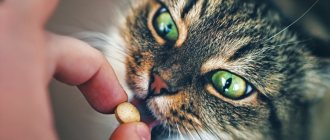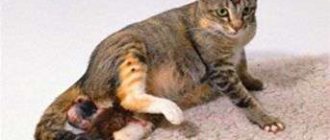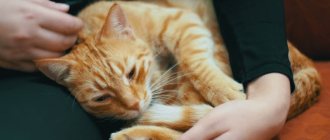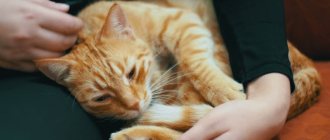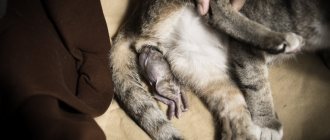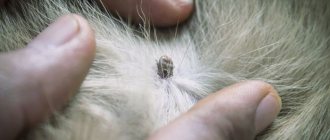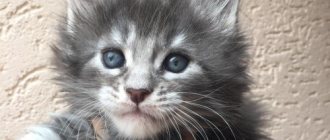4389Administration
Pets give their owners many pleasant moments of communication and play, but their good mood and well-being require regular monitoring of their condition. Cats in the house are not uncommon, and knowing how to give birth to a cat at home will make it possible to help her if necessary and prevent possible complications. After all, childbirth in animals, being a normal physiological process, is a crucial moment that determines the health of babies and the preservation of the full life of an adult animal.
Pregnancy detection
Healthy pets with a pedigree, veterinary passport and breeding value are allowed for breeding. In practice, a different picture can be observed. Domestic cats that freely visit the street find outbred males who do not have any regalia for mating.
It will not be possible to register the offspring from such matings in the breed club, so the kids will have to look for a new home for a very long time, and the kittens will be given away not for money, but for free. But this is the financial side of the issue, which, of course, should be foreseen in advance.
If mating is carried out under human control, and titled individuals participate in the process, the date of fertilization must be recorded. This will help determine the estimated date of birth of the offspring. When mating occurred without the knowledge of the cat owner, the gestational age can be determined by physiological signs and the changed behavior of the pet.
During pregnancy, the cat’s body undergoes restructuring, as evidenced by the following physiological signs:
- absence of heat. Pets over the age of 1 year estrus quite often (every 1-2 months), the onset of estrus can be recognized by characteristic behavior: purring, rubbing on the floor, night screams. If the cats' next calls do not occur as scheduled, it means the cat is pregnant;
- At about 3 weeks of pregnancy, the cat’s nipples swell and turn red;
- after the 4th week, you can notice rounded sides, and after the 6th week, the kittens can be felt moving in the womb.
To make sure that pregnancy has occurred, you need to show the animal to a veterinarian.
If mating proceeds according to a pre-planned plan, then the animals participating in the process must be checked for bacterial and infectious pathologies. In addition, before mating, animals must be treated for worms and other parasites.
Unplanned mating can be a reason for abortion. In the early stages of pregnancy this is allowed. Termination is also carried out for medical reasons, for example, if the pregnancy threatens the life and health of the pet.
Signs of the onset of labor
A day before the onset of labor in a cat, the signs that appeared earlier are supplemented by another - a decrease in body temperature by 1°C.
If the pet is accustomed to regularly measuring its temperature, then this method will help determine as accurately as possible the approach of delivery. If this procedure is new to the owner and the mother in labor, it is better not to start it at such a moment, but simply leave the animal alone. Before you give birth to a cat, you must prepare a “rescue” set of tools and equipment, including:
- antiseptic and disinfectant;
- scissors, dental floss;
- pipette, baby syringe, disposable syringes
- surgical gloves
- gauze napkins;
- petrolatum;
- toilet paper;
- garbage bags;
- diaper;
- heater;
- stopwatch.
You should also have the veterinarian's phone number at hand. All this may not be necessary, but it is better to prepare for any development of the situation.
The immediate beginning of the labor process will be indicated by rapid breathing and the first contractions, during which the woman in labor usually meows and stretches her teeth towards her back. This stage can last from several hours to a day. At this time, you should not disturb the animal, and especially not arrange crowded viewings, since with excessive attention, the cat can eat newborn cubs.
Pregnancy in cats lasts, on average, 60 days. But since each organism is individual, it is not possible to predict the exact date of the upcoming birth, even if the pet was purposefully brought together with a cat.
The most informative indicator is the following fact: before labor begins, the cat’s water and plug break. Detecting this phenomenon in time can be problematic, since the expectant mother will lick herself, and not every owner will be able to be near her all the time. Therefore, you need to pay attention to other signs of impending delivery:
- within a day or two, the cat’s mammary glands increase in volume and colostrum is released;
- the pet’s behavior changes - it becomes indifferent to food, meows a lot, can show aggression and hide, or, on the contrary, follow the owner’s heels;
- a few days before giving birth, the expectant mother looks for a suitable secluded place for this;
- the cat often licks its stomach and genitals;
- the pet’s body temperature decreases;
- approximately 5 hours before delivery, the animal’s spine acquires a characteristic curve.
A cat's pregnancy lasts about 65 days. Owners who breed the breed must know when fertilization occurred, so they can easily give a preliminary date for the start of labor in the animal. However, lambing does not always occur on time, and in most cases the date of onset of pregnancy is unknown, so it is important to remember the physiological signs by which one can judge the onset of labor in a pet:
- About a day before the onset of contractions, the cat becomes nervous and restless. She meows for no reason and is in search of a secluded place for future delivery;
- her appetite suddenly disappears, but her need to drink increases;
- two days before birth, lactation may begin - the release of colostrum from the mammary glands;
- Just before birth, a mucous plug comes off, which the pet tries to lick off.
Nutrition tips
The onset of pregnancy in a cat requires a review of its diet. From the 4th week, nutrition should be enhanced. If the cat was previously fed 2 times a day, then it is transferred to fractional feeding. The fruits developing in the womb begin to put pressure on the organs of the digestive tract, so the cat is not able to eat the previous portion of food at one time (read what to feed a pregnant cat).
An incorrectly formulated diet leads to the cat losing weight, and in severe cases, suffering from exhaustion. Diet errors are dangerous not only for the pregnant woman, kittens can also suffer. A starving cat's offspring are born weak and developmentally delayed. Lack of vitamins and microelements leads to the following deviations:
- against the background of improper mineral metabolism, problems with bone tissue appear, expressed in the terrible condition of bones and teeth. Babies grow up with curvature of limbs (rickets);
- Developmental defects are observed due to a lack of vitamins in the diet. This also negatively affects the nervous system and internal organs;
- improper salt metabolism ends in pathology of the structure of the teeth;
- Miscarriages occur when there is a lack of protein and amino acids in the diet. Without these substances, fruits do not develop, and the body gets rid of them.
To get healthy offspring, you need to take care of the proper nutrition of your pet even before pregnancy. In the first month after fertilization, all organs and systems of babies develop, which is why it is so important to pay attention to diet.
You should not purchase various food additives or vitamins from pet stores without consulting a veterinarian. Only a specialist should recommend what should be included in the diet. An excess of minerals and vitamins is just as dangerous as their deficiency.
The weight of a cat is of great importance, so it is necessary to weigh it regularly and record the data in a notebook. Fluctuations in indicators may indicate deviations; only a veterinarian can dispel doubts.
An increased appetite and rapid weight gain can cause obesity. This condition is a risk factor during pregnancy and childbirth.
Choosing a nest site
If you don't prepare a cozy and safe nest for your cat, she may find it on her own. In this case, it will be difficult to observe the birth process, because the cat can hide far under the sofa, behind a closet, in an open dresser drawer or some secluded place hidden from prying eyes.
About 2-3 weeks before giving birth, the pet begins to search for a nesting site. It is necessary not to miss this moment and offer the cat a good nest located within the owner’s reach. To arrange the nest, a durable box made of cardboard or plastic, which must be covered with a soft cloth, is suitable. This will make the habituation process easier, and the cat will be happy to rest in the nest. You will need another box in which to place newborn kittens.
During the birth process, the cat begins to discharge, so it is advisable to put a moisture-absorbing diaper in the box.
After the pets are born, the diaper is removed and the box is covered with natural cotton napkins. The fabric should not have any odors so as not to displease the cat. Until the umbilical cords fall off, the bedding must be changed at least once a day. Therefore, they prepare more of these napkins.
If before giving birth the cat realizes that the place for babies is not safe enough, she will move away from everyone. However, this cannot be allowed. After all, it is very difficult to help a woman in labor who is stuck under the sofa. In order not to frighten the cat away, it is better to allocate a separate room for labor, limiting access to children, other pets and strangers.
Postpartum problems
The table below highlights the most common problems that arise during the birthing process in cats and kittens, which the owner can overcome on their own.
Contractions have stopped or become weak
You need to wait some time. When 1-2 kittens are born, labor may subside and then reactivate (in some cases it can take up to a day). Labor can be stimulated by massaging the mammary glands and nipples. In extreme cases, it is possible to use oxytocin, a drug that promotes contractions of the uterine wall. It should be borne in mind that improper use of the product can cause the death of the mother and offspring. We invite you to familiarize yourself with: The largest cat breeds in the world
The membrane remained intact
If the mustachioed mother has not torn the membrane of the amniotic sac, you need to carefully tear it apart, starting from the kitten's face.
The cub can't get out
If the baby gets stuck in the birth canal, the owner will have to help him: to do this, grab the kitten by the skin (on the withers or back of the body) and slowly pull it out. Manipulation should be carried out wearing gloves, the tips of which should be lubricated with Vaseline oil.
If the woman in labor has not gnawed the umbilical cord, and more than a quarter of an hour has passed since the kitten was born, it is necessary to do the following: step back from the kitten’s tummy about 4 cm, bandage or clamp it, and after half a minute cut it at the point of compression. The incision site must be treated with an antiseptic (brilliant).
You can try to gently shake it, lowering its muzzle down. A sign of oxygen entering the respiratory system is the pink color of the newborn’s tongue. In addition, it should make a squeaking noise.
Cat ignores baby
In this case, the owner must carry out the initial treatment of the kitten. It is necessary to wipe the newborn with a cloth and remove mucus from the respiratory tract using a syringe. After this, you need to place the baby on the nipple.
Childbirth is behind us, but the owner must remain vigilant - the cat may develop new problems. The table shows the most common ones and ways to solve them.
The cat refuses to eat
Immediately after giving birth, the cat may not ask for food for up to 6 or more hours due to the afterbirth eaten. If you fast for more than a day, you can give her low-fat broth; it contains extractive substances that stimulate the digestive activity of enzymes and the functioning of the gastrointestinal tract. If you have an intestinal disorder (may occur due to a large amount of afterbirth eaten), you need to give the pussy sorbents. When the mother's condition stabilizes, she will develop an appetite. It is important that she drinks water while refusing food.
The animal does not visit the litter box
In the first four days after giving birth, the cat may not want to go to the toilet. This is a normal phenomenon associated with the formation of milk and the restoration of internal organs, which requires a lot of fluid.
There is a discharge mixed with blood
If the volume is small, a cat’s discharge within two days after birth is considered normal and goes away on its own. You need to sound the alarm if the discharge has a pronounced scarlet color, lasts more than two days, or intensifies. This may be a sign of internal uterine bleeding or the presence of serious tissue ruptures. The cat should be taken to a veterinarian immediately.
A woman in labor has no milk
There can be many reasons for this phenomenon - from the cat’s stressful state to internal endocrine disorders. It is important to provide the new mother with complete peace: care should not be excessive. There is no need to move the box with the family to a new place or pick up the kittens. It is necessary to ensure that they are not disturbed by other pets or children. If bowls of food and drink, as well as a tray, are located far from the place where the cat and kittens are located, the pet may worry about the cubs, leaving when necessary. In addition, for a cat to have a sufficient amount of milk, its diet must include dairy and fermented milk products and water.
First of all, it is necessary to exclude the possibility of the presence of a kitten in the uterus, while a dead fetus poses a great danger. You can independently determine its presence by palpation, but it is better to go to the clinic and do an ultrasound. In the absence of a fetus, the cause of the abdomen may be intestinal disorders, helminths, or difficulty with defecation.
The amniotic sac may rupture as the kitten passes through the birth canal, or the cub may be born in it. In some cases, the membranes are expelled before the kitten is born. You can't let the cat tear it apart before the baby arrives. An emerging bladder without a fetus after delivery is not considered a pathology and does not pose a danger to the animal - it is a physiological feature.
Signs of eclampsia appeared
Eclampsia is a phenomenon based on calcium deficiency in the cat’s body. Symptoms: increased salivation, poor coordination of movements, anxiety, increased body temperature, convulsive muscle contractions. This condition leads to the death of the animal, so at the slightest sign you need to urgently take the cat to the clinic. A preventive measure is to take calcium-containing products during the period of gestation and feeding of kittens.
Dangerous symptoms
Excessive restlessness of the cat, copious discharge of an unusual color with an unpleasant odor should concern the owner. During a normal pregnancy, there should be no discharge before birth. The following symptoms warn of pathology:
- yellow-green discharge from the loop. Most likely, this is pus, provoked by the development of an infectious process in the uterus;
- the putrid smell of the discharge, its bright green tint occurs after the intrauterine death of kittens. Decomposition of the placenta is accompanied by unpleasant discharge;
- Blood may appear from the loop. This is also a dangerous signal warning of ruptured blood vessels or perforation of the uterus.
Pregnancy is a difficult test for the whole body. Stress leads to a decrease in immunity, so the cat can get a viral infection. Symptoms such as vomiting, diarrhea, sneezing, mucous or purulent discharge from the nose and eyes should be a reason to contact a veterinarian. Infectious diseases are fraught with the death of offspring or the formation of abnormalities.
Baby's date of birth
The period of birth of kittens varies within 60-70 days after mating. Day 65-67 is considered optimal, but the body of each woman in labor is individual, so you should not rush to conclusions. If labor has not occurred by day 71, surgery is performed.
Decreased appetite on the eve of childbirth indicates the imminent arrival of babies. From this point on, it is necessary to conduct active preparations, call the veterinarian and arrange an appointment if the need arises.
End of labor
Labor can be considered completed if more than 2 hours have passed since the last contractions. A cat after giving birth behaves as follows:
- her breathing is restored - it becomes smooth and calm;
- she shows an active interest in newborns - licks them, turns them over;
- takes a different position, adjusts to the kittens in order to feed them;
- feels thirsty and hungry;
- goes to the toilet.
It is undesirable to pick up kittens; some mothers refuse to accept the cubs after this. The place where the birth took place needs to be put in order. To do this, the mother and offspring are carefully moved to a temporary bedding and returned back after cleaning. To prevent the pet from leaving the kittens for a long time, it is better to place the tray and bowls nearby.
Childbirth kit
The process of giving birth to kittens is always exciting for owners. In order not to confuse anything in the chaos, you need to prepare in advance. The following items and tools should be placed near the nest:
- several disposable moisture-absorbing diapers;
- sterile gauze wipes, size 20x20 cm;
- a skein of thick silk thread that can be used to tie the umbilical cord;
- scissors for cutting the umbilical cord;
- stable container with water;
- small syringe;
- heating pad for babies;
- medical gloves;
- notebook;
- pen.
A first aid kit must be present. It contains:
- medical alcohol for disinfecting hands and instruments;
- hydrogen peroxide for treating the umbilical cord and occasional wounds;
- Streptocide, crushed into powder.
In addition, the first aid kit should contain ampoules with antibiotics, hormonal drugs and vitamins. This will allow emergency assistance to be provided to the woman in labor if necessary. The veterinarian will recommend the names of drugs for the first aid kit; after purchase, it is advisable to study the instructions and write down on a piece of paper what doses of the drug may be required.
Help for a woman in labor
In most cases, the owner's assistance during childbirth is not required. If the cat is confident in its actions and is not nervous, it is better to just watch the process. Inept human actions can only frighten the animal and increase stress.
The woman in labor is closely monitored.
Sometimes during contractions the cat goes to the litter box. Therefore, it is necessary to place the tray near the birth site and monitor that the cat does not give birth when visiting the toilet.
When a fetal sac appears in the cat's birth canal, it is necessary to transfer the pet to the nest.
Contractions usually last up to 12 hours. If contractions are weak, the break between them is up to 40 minutes. During strong contractions, the cat behaves restlessly, contractile movements of the peritoneum are visually noted.
Active licking of the genitals indicates the imminent approach of childbirth, while the cat’s breathing becomes heavier, and the pet may meow. The animal's body temperature 12-24 hours before labor can drop to 37ºC.
During childbirth, it is necessary to control the amount of placenta released. In order not to confuse anything in the turmoil, the time of birth of each baby and the expulsion of the placenta are recorded in a notebook. If after birth the number of kittens does not correspond to the number of afterbirths released, the cat must be taken to the veterinarian. Placences remaining in the womb can trigger the development of endometritis.
The apartment should be as quiet and calm as possible during childbirth. Excessive noise, strangers and the attention of other pets cause anxiety in the woman in labor, which contributes to a protracted labor, and in some cases can cause the death of the fetus.
As soon as your cat begins to strain, you need to thoroughly wash your hands and prepare. During a normal birth, the cat takes a position on its side and pushes. It takes several attempts (3-4) for the kitten to appear. When an amniotic sac appears in the birth canal, the cat breaks it and begins to actively wash the baby.
Licking continues until the kitten begins to breathe. Following the kitten, the placenta is expelled from the uterus. Many cats eat the afterbirth after gnawing off the umbilical cord. The substances that make up the placenta help stimulate labor, so you can allow your pet to eat them. It is advisable that no more than 4 pieces are eaten, otherwise the cat may develop diarrhea.
A newborn baby can speed up the appearance of new contractions. The mother pushes him to the nipples, where the kitten begins to suckle colostrum. The time period required for the birth of the next babies is approximately 20-40 minutes. For the second and subsequent fetuses, fewer attempts are required (2-3 for each).
The birth is considered complete if 2 hours have passed since the birth of the last baby.
In some cases, it happens that the baby is born a few hours later. This indicates weak labor.
The veterinary clinic offers to undergo an ultrasound to accurately know the number of future babies. It is better to do this in the last week before giving birth. Embryos that die in the uterus in the early stages tend to dissolve, so early studies are considered uninformative.
Preparing for lambing
Every owner worries about how to help a cat give birth to healthy offspring. To do this, certain measures should be taken.
Arrangement of the nest
- It is unlikely that a mother will give birth on a thin bedding or bare floor. Definitely, she will look for a more comfortable place.
- Take a shallow, wide box and lay a mattress or a soft, unnecessary jacket on its bottom. You can sew a mattress yourself by stuffing it with padding polyester, or you can use a towel or blanket for these purposes.
- Make sure that there are no buttons or threads sticking out of the bedding. In addition, the fabric should not slip so that kittens can crawl on it freely.
- Immediately before giving birth, the kitten needs to be placed in a nest so that she can pre-settle in there.
- Be prepared for the fact that the capricious person may not like your carefully prepared “maternity hospital”, and she will go to huddle in the closet or on your bed.
- To attract the animal, place the “house” in a dark and quiet place.
- Once the mother is settled in, place disposable pet bedding on the bottom.
To ensure your cat gives birth without any problems, prepare:
- cotton threads;
- petrolatum;
- scissors;
- antiseptic;
- cloths or diapers.
In addition to all of the above, you should always have a 24-hour veterinary emergency number at hand. Just in case, have a carrying bag ready.
As the moment of delivery approaches, the cat changes its behavior:
- becomes restless;
- constantly licks the belly and the area under the tail;
- looking for a secluded place, trying to climb into the closet and arrange a bed.
Such changes begin about a week before lambing. Having noticed them, you need to make adjustments to the diet, reducing portion sizes and increasing the number of feedings. This is due to the fact that the kittens inside do not allow the stomach to stretch to its usual size.
The second step is to visit the veterinarian for a prenatal examination and obtain the necessary advice. Also, for a long-haired cat, the doctor can trim the hair near the tail and around the nipples, but this is also not difficult to do yourself.
If any deviations from the normal course of pregnancy are noted, it is better to have a specialist deliver the cat. If your pet is in good condition, you can accompany this process yourself.
Another preparatory moment is arranging a place for the future woman in labor. To do this, there is no need to purchase anything extra, since the animal will prefer a secluded place to any special bed. Therefore, it is recommended to take a regular but suitable-sized (quite spacious) box with a lid, cut a hole in the side and place a clean rag on the bottom. It is advisable to place it in a separate room where people rarely enter. Bowls for food and drink are located nearby, and a little further away there is a litter tray.
You need to thoroughly prepare for childbirth. To do this, you will need not only to arrange the place where the kittens will appear, but also to prepare some tools and materials that may be needed in case of complications that arise. In addition, you should make sure that you have medications on hand and be sure to write down the veterinarian’s phone number so that you can contact him at any time.
A large box is perfect for temporary housing for the mother and her offspring. To make it easier for the cat to climb into it, one side can be made lower than the rest. It is not recommended to make a slot along the entire height of the box to prevent the kittens from escaping.
Mother cat with her kittens
The bottom of the box can be covered with a rubber or foam mat, or a piece of similar material, oilcloth. This will protect the cardboard from accidental wetness. Place a cloth or disposable diaper on top.
It is advisable for the box to stand in the place chosen by the cat, but, in most cases, mustachioed mothers prefer closets or the owner’s bed. The place where the box will be placed should be quiet, warm, and secluded. You need to gradually accustom your pet to the “nest” by placing drinking water and food nearby. In the end, she will understand what is required of her and will accept the proposed option.
By the time of birth, items should be prepared that may be needed if the situation takes an unexpected turn:
- scissors;
- sterile rubber gloves;
- Vaseline oil;
- antiseptic (brilliant);
- syringe;
- dishes for clean water;
- cotton buds;
- threads;
- syringes of different sizes;
- disposable diapers;
- pieces of cotton fabric (they must be pre-washed and ironed).
All accessories must be in one place and in “combat readiness”: clean and disinfected.
In some cases, your mustachioed pet may need medical assistance, so in addition to the tools, you should prepare some medications.
- Oxytocin. It will help with a sudden cessation of contractions or weak labor. Promotes contraction of the uterine walls. Used as injections into the withers area in a dosage of 0.2 ml.
- Travmatin. As soon as the woman in labor begins, you can give an injection of this drug in a dosage of 1 ml. After the end of childbirth, the drug is used for the next three days, one injection per day. Travmatin eliminates pain, prevents the development of the inflammatory process, has an antimicrobial effect, and reduces the likelihood of infectious complications.
- Calcium gluconate. In the form of an injection solution, it is used in a dosage of 1 ml for the normal course of labor and the prevention of eclampsia.
We suggest you read: What is the normal temperature for cats?
A cat is a very strong and fertile animal, so it does not require special preparation for childbirth. She herself knows how to take care of herself and her offspring. The owner’s job is to provide his pet with comfortable conditions for a successful birth without interfering in the process itself. You should start preparing about a week before the expected date of birth.
The place for giving birth to a cat, and subsequently raising kittens, should be secluded and familiar to her, without drafts and dampness, as well as other pets. There you need to put an ordinary cardboard box, the area and height sufficient to freely accommodate the animal and its cubs.
An ordinary cardboard box can serve as a “nest” for childbirth.
Childbirth in a cat, although rare, can be accompanied by some force majeure circumstances, so the owner must know how to help his pet when it occurs, and have the necessary means at hand for this. These include:
- clean diapers;
- moisture-absorbing wipes;
- silk thread for tying the kitten's umbilical cord;
- scissors (preferably medical, with rounded ends);
- disinfectants (ethyl alcohol, iodine, brilliant green, chlorhexidine) for treating the owner’s hands and kittens’ navels;
- small enema (for sucking amniotic fluid from kittens’ noses);
- oxytocin ampoule;
- syringes for injection of drugs.
Possible complications
There are times when a cat cannot give birth. In order not to get confused in such a situation, it is important to understand what is a deviation and what is the norm. An urgent call to the veterinarian is necessary in the following cases:
- the first contractions last more than 12 hours;
- pushing lasts more than 60 minutes;
- More than 1-2 hours have passed since the first kitten appeared, but there is no more pushing;
- the fetus is stuck in the birth canal and has been there for more than 20 minutes, but the pushing has stopped.
Help provided unprofessionally can only do harm. Therefore, without hesitation, you should call a veterinarian at home. If the specialist’s arrival is delayed, you can try to help a cat whose pet is stuck in the birth canal. To do this, fill the syringe with petroleum jelly, remove the needle and generously lubricate the loop area.
You can pull the kitten out only during the next push. Excessive force is prohibited. This may result in injury to the birth canal and the baby.
Resuscitation actions
Sometimes dead kittens are born. This usually occurs when the fetus is malpresented and has a long passage through the birth canal. In this case, you can try to resuscitate the kitten. The baby is wiped with a dry cloth or towel and placed on a heating pad or under a lamp. It is necessary to perform a closed cardiac massage and perform artificial respiration.
Before carrying out measures for ventilation of the lungs, it is necessary to free the nasal passages and oral cavity from amniotic fluid. If the cat itself has not licked the baby, use a small syringe or syringe without a needle. Only after clearing the airways do resuscitation measures begin.
If the revival measures were successful, the kitten begins to squeak. He is placed on a heating pad and left for 10-15 minutes to restore strength. When the baby actively moves his limbs, he is transferred to the mother's nipples. If the pet is lethargic, it is rubbed again and warmed under a lamp, observing the restoration of mobility.
If the kitten was born in the amniotic sac, and the mother went about her business, it is necessary to rupture the membrane of the bladder near the muzzle and remove fluid from the respiratory tract. After the baby has begun to breathe, the umbilical cord is cut at the thinnest point, leaving about 5 cm. The baby is rubbed.
Also watch the video of the entire process of giving birth to a cat with assistance:
How does childbirth occur in cats?
Conventionally, there are three stages of delivery in cats.
Immediately before giving birth, the cat becomes restless. Her mouth may be open, she is breathing heavily, and meowing. Small amounts of bleeding may occur. Since contractions are already beginning, the movement of the kittens can be determined by the surface of the abdomen - they take a position one after another, turning their heads towards the exit. This stage lasts from 5-12 hours to a day and a half (often during the first birth).
A kitten is born. Each may take 5-30 minutes. The break between the first and second baby is longer than the others, then the kittens follow each other.
The placenta comes out after the kitten.
The immediate appearance of offspring occurs as follows:
- the animal pushes, helping the kittens move out;
- a kitten appears, it can come out both in the amniotic sac and without it (in the process of passing through the birth canal it often bursts);
- the mustachioed mother herself removes the remains of the bladder from the cub, and then licks it, clearing the airways;
- the woman in labor does not immediately gnaw the umbilical cord, but when the placenta comes out (it is important to count the placenta so that there are as many of them as there are babies, the placenta remaining in the uterus is a source of infection);
- the baby attaches to the nipple.
The cat usually eats the afterbirth. Placental tissue contains hormonal compounds and biological active substances that ease contractions, promote milk production, and have a positive effect on the recovery of the pet after childbirth. But you don’t need to give her more than 2-3 - vomiting or diarrhea may occur.
Attention: a newborn baby should squeak after being licked by a cat. If this does not happen, you need to check whether he is breathing and, if necessary, take appropriate measures.
